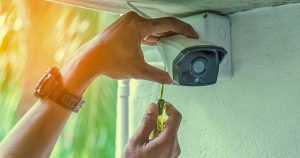9 Ways to Make Your Backyard a Safer Place to Play
To keep summer fun extra safe this year, take a peek at our summer safety guide. Sun exposure, pool hangs, vacation, landscaping—you name it, we have tips for it.
Backyards are synonymous with summer fun—offering your kids fresh air, exercise, and hours of entertainment. But backyards can be surprisingly dangerous places, too. Following a few simple safety guidelines can go a long way toward thwarting outdoor injuries.
Here are 10 ways to help ensure your child’s outdoor play area is as safe as it is fun.
1. Establish safety rules.
Before summer is in full swing, have your kids help you establish rules for safe outdoor play. Write the rules on a piece of paper and post it somewhere visible. When playmates come over, make sure they understand your household’s outdoor rules. Here are a few of the safety guidelines you’ll probably want to include:
- Don’t chase, push, or roughhouse while playing on slides, climbing walls, or swings.
- Use all play equipment properly—no standing on swings, jumping off high platforms, walking up slides, etc.
- Place your bikes, backpacks, and other personal items away from the play area to avoid trips and falls.
- Always wear close-toed shoes. Never wear loose clothing, jewelry, or other items that could get caught in equipment.
- Stay away from off-limits areas like the garage, shed, or anywhere in the yard where you can’t be seen.
2. Survey your yard for possible hazards.
Before your kids go out to play, pick up items that could present a danger—like garden tools, ladders, hoses, and chemicals. Put these items in a secure place that can’t be accessed by your child or their friends. Also survey your yard for natural hazards, such as holes, low tree limbs, thorns, and fire ant mounds. Make sure outdoor play structures like tree forts and playhouses are free of stinging insect nests, and regularly inspect sandboxes for bugs and animal droppings.
3. Supervise children at all times.
Kids (especially young ones) can’t always recognize potentially dangerous situations—which is just one reason they should be supervised by an adult while playing outdoors. If an accident does occur, the adult in charge can respond to the injured child immediately. Also, by supervising your kids’ backyard fun, you can be sure they take rest breaks, stay hydrated, and reapply sunscreen and bug repellant as necessary.
4. Install a fence.
Fences outfitted with self-closing and self-latching gates can help ensure your kids and pets remain in your yard. If you can’t install a fence, set well-defined boundaries within which your children can play. For added peace of mind, outfit your young children with a kid-friendly GPS tracker. These small high-tech devices can help you locate your child if they wander outside of your yard.
5. Eradicate poisonous plants and flowers.
Tweens and teens usually know better than to eat unfamiliar vegetation, but your toddler might find a sweet-smelling flower irresistible. Once ingested, many popular plants and flowers can become toxic. Call the American Association of Poison Control Centers’ Poison Help line at 1-800-222-1222 if you think your child has eaten a poisonous plant or flower. If potentially toxic plants are growing in your yard, don’t take chances—remove them and consider building a kid-safe play garden instead.
6. Improve the security in and around your pool.
Pools can be dangerous—particularly for young children. In fact, drowning is the leading cause of death for children under the age of four, and most of these drownings take place in residential swimming pools. Hot tubs also pose a serious threat to your child’s safety. Make sure your hot tub’s cover is securely latched when not in use.
To help prevent pool accidents, keep doors and windows leading to the pool area locked at all times, and add door and window sensors for an extra layer of protection. You may also want to purchase one or more safety gadgets made specifically to minimize the risks associated with pools. Regardless of what precautions you take, remember that nothing can replace adult supervision.
7. Use caution when grilling.
Family cookouts are an all-American pastime, but grills can be dangerous for kids. Before using your grill, move it away from play areas and establish a safety line that kids aren’t allowed to cross. Never leave a grill unattended, and make sure items such as lighter fluid, matches, and propane are locked up immediately after use.
8. Check play structures for signs of wear.
Playsets featuring multiple play stations, like slides, climbing walls, and swings, encourage exercise and imaginative play. But they must be well-maintained and checked periodically for signs of wear. Swing set hazards you should look for include rotting wood, protruding bolts, damaged floor boards, and loose steps and railings. Use a playset safety checklist to quickly identify unsafe items, and then fix them before you allow your child to use the equipment.
If you’re shopping for a playset, make sure it meets the American Society for Testing and Materials (ASTM) standards for residential playground equipment. Beware that used playsets may not meet these standards and could be structurally weak. For safety’s sake, buy a new playset instead.
9. Nix the trampoline.
Trampolines have a high amusement value, but they are also notoriously risky. A study conducted by the Pediatric Orthopaedic Society of North America found that over a nine-year period, more than 1 million people visited emergency rooms for trampoline-related injuries. Almost one-third of the injuries involved broken bones, and 90% of these fractures occurred in kids 16 years of age and younger. Statistics like these could be why the American Academy of Pediatrics (AAP) advises parents against recreational trampoline use.
If you choose to have a trampoline in your backyard, know that 75% of trampoline injuries happen when more than one person is jumping at a time, so don’t allow this behavior. Also, check your homeowners policy to find out if it covers trampoline-related injuries—many policies don’t.
Outdoor play is a critical part of your child’s physical and social development. Following these safety tips can help ensure your kids enjoy Mother Nature accident-free. Learn more about how to make your backyard less dangerous and discover how a monitored home security system can add to your family’s overall safety and security.
Recent Articles




The post 9 Ways to Make Your Backyard a Safer Place to Play appeared first on SafeWise.
Article source here: 9 Ways to Make Your Backyard a Safer Place to Play